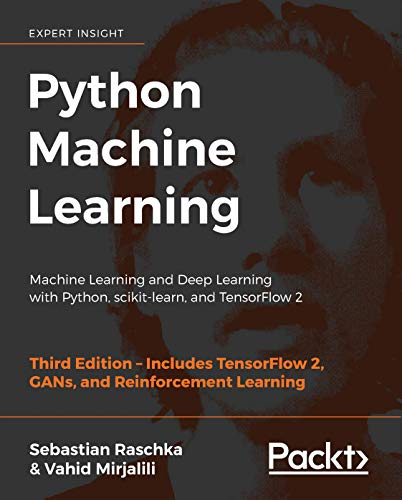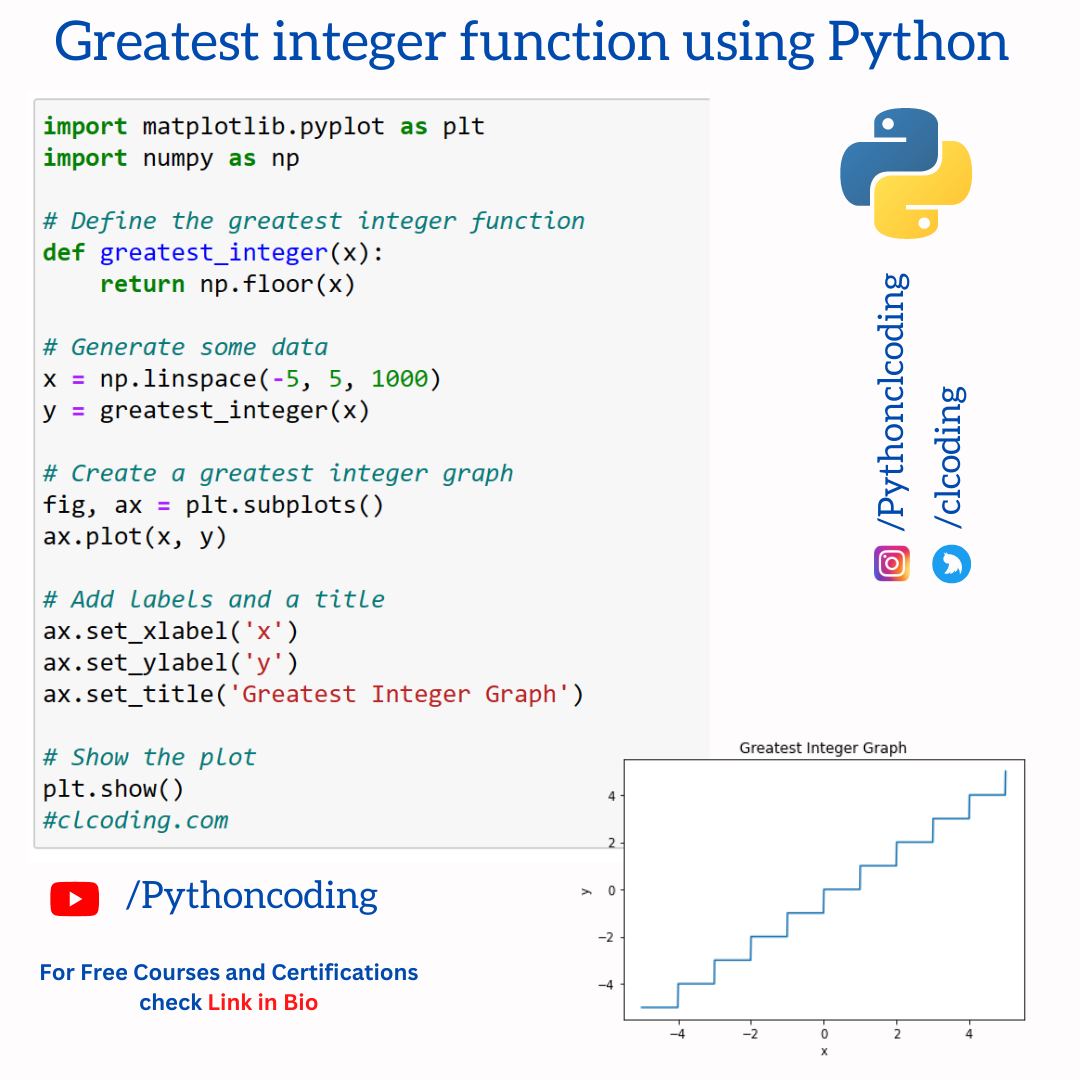1. "Python for Data Analysis" by Wes McKinney - This book focuses on data manipulation and analysis using Python's pandas library.
Get the definitive handbook for manipulating, processing, cleaning, and crunching datasets in Python. Updated for Python 3.10 and pandas 1.4, the third edition of this hands-on guide is packed with practical case studies that show you how to solve a broad set of data analysis problems effectively. You'll learn the latest versions of pandas, NumPy, and Jupyter in the process.
Download - Python for Data Analysis
2. "Hands-On Machine Learning with Scikit-Learn, Keras, and TensorFlow" by Aurélien Géron - A practical guide to machine learning using Python libraries like Scikit-Learn, Keras, and TensorFlow.
Through a recent series of breakthroughs, deep learning has boosted the entire field of machine learning. Now, even programmers who know close to nothing about this technology can use simple, efficient tools to implement programs capable of learning from data. This bestselling book uses concrete examples, minimal theory, and production-ready Python frameworks (Scikit-Learn, Keras, and TensorFlow) to help you gain an intuitive understanding of the concepts and tools for building intelligent systems.
With this updated third edition, author Aurélien Géron explores a range of techniques, starting with simple linear regression and progressing to deep neural networks. Numerous code examples and exercises throughout the book help you apply what you've learned. Programming experience is all you need to get started.
Use Scikit-learn to track an example ML project end to end
Explore several models, including support vector machines, decision trees, random forests, and ensemble methods
Exploit unsupervised learning techniques such as dimensionality reduction, clustering, and anomaly detection
Dive into neural net architectures, including convolutional nets, recurrent nets, generative adversarial networks, autoencoders, diffusion models, and transformers
Use TensorFlow and Keras to build and train neural nets for computer vision, natural language processing, generative models, and deep reinforcement learning
Download - Hands-On Machine Learning with Scikit-Learn, Keras, and TensorFlow
3. "Data Science from Scratch" by Joel Grus - A beginner-friendly introduction to data science concepts and tools using Python.
To really learn data science, you should not only master the tools—data science libraries, frameworks, modules, and toolkits—but also understand the ideas and principles underlying them. Updated for Python 3.6, this second edition of Data Science from Scratch shows you how these tools and algorithms work by implementing them from scratch.
If you have an aptitude for mathematics and some programming skills, author Joel Grus will help you get comfortable with the math and statistics at the core of data science, and with the hacking skills you need to get started as a data scientist. Packed with new material on deep learning, statistics, and natural language processing, this updated book shows you how to find the gems in today’s messy glut of data.
Get a crash course in Python
Learn the basics of linear algebra, statistics, and probability—and how and when they’re used in data science
Collect, explore, clean, munge, and manipulate data
Dive into the fundamentals of machine learning
Implement models such as k-nearest neighbors, Naïve Bayes, linear and logistic regression, decision trees, neural networks, and clustering
Explore recommender systems, natural language processing, network analysis, MapReduce, and databases
Download - Data Science from Scratch: First Principles with Python
4. "Python Data Science Handbook" by Jake VanderPlas - Covers essential data science libraries in Python, such as NumPy, pandas, Matplotlib, and Scikit-Learn.
Python is a first-class tool for many researchers, primarily because of its libraries for storing, manipulating, and gaining insight from data. Several resources exist for individual pieces of this data science stack, but only with the new edition of Python Data Science Handbook do you get them all--IPython, NumPy, pandas, Matplotlib, scikit-learn, and other related tools.
Working scientists and data crunchers familiar with reading and writing Python code will find the second edition of this comprehensive desk reference ideal for tackling day-to-day issues: manipulating, transforming, and cleaning data; visualizing different types of data; and using data to build statistical or machine learning models. Quite simply, this is the must-have reference for scientific computing in Python.
With this handbook, you'll learn how:
IPython and Jupyter provide computational environments for scientists using Python
NumPy includes the ndarray for efficient storage and manipulation of dense data arrays
Pandas contains the DataFrame for efficient storage and manipulation of labeled/columnar data
Matplotlib includes capabilities for a flexible range of data visualizations
Scikit-learn helps you build efficient and clean Python implementations of the most important and established machine learning algorithms
Download - Python Data Science Handbook
"Deep Learning" by Ian Goodfellow, Yoshua Bengio, and Aaron Courville - A comprehensive reference on deep learning techniques and applications.
Deep learning is a form of machine learning that enables computers to learn from experience and understand the world in terms of a hierarchy of concepts. Because the computer gathers knowledge from experience, there is no need for a human computer operator to formally specify all the knowledge that the computer needs. The hierarchy of concepts allows the computer to learn complicated concepts by building them out of simpler ones; a graph of these hierarchies would be many layers deep. This book introduces a broad range of topics in deep learning.
The text offers mathematical and conceptual background, covering relevant concepts in linear algebra, probability theory and information theory, numerical computation, and machine learning. It describes deep learning techniques used by practitioners in industry, including deep feedforward networks, regularization, optimization algorithms, convolutional networks, sequence modeling, and practical methodology; and it surveys such applications as natural language processing, speech recognition, computer vision, online recommendation systems, bioinformatics, and videogames. Finally, the book offers research perspectives, covering such theoretical topics as linear factor models, autoencoders, representation learning, structured probabilistic models, Monte Carlo methods, the partition function, approximate inference, and deep generative models.
Deep Learning can be used by undergraduate or graduate students planning careers in either industry or research, and by software engineers who want to begin using deep learning in their products or platforms. A website offers supplementary material for both readers and instructors.
Download - Deep Learning (Adaptive Computation and Machine Learning series)
"Data Science for Business" by Foster Provost and Tom Fawcett - Explores the intersection of data science and business decision-making.
Written by renowned data science experts Foster Provost and Tom Fawcett, Data Science for Business introduces the fundamental principles of data science, and walks you through the "data-analytic thinking" necessary for extracting useful knowledge and business value from the data you collect. This guide also helps you understand the many data-mining techniques in use today.
Based on an MBA course Provost has taught at New York University over the past ten years, Data Science for Business provides examples of real-world business problems to illustrate these principles. You’ll not only learn how to improve communication between business stakeholders and data scientists, but also how participate intelligently in your company’s data science projects. You’ll also discover how to think data-analytically, and fully appreciate how data science methods can support business decision-making.
Understand how data science fits in your organization—and how you can use it for competitive advantage
Treat data as a business asset that requires careful investment if you’re to gain real value
Approach business problems data-analytically, using the data-mining process to gather good data in the most appropriate way
Learn general concepts for actually extracting knowledge from data
Apply data science principles when interviewing data science job candidates
Download - Data Science for Business: What You Need to Know about Data Mining and Data-Analytic Thinking
"Python Machine Learning" by Sebastian Raschka and Vahid Mirjalili - A hands-on guide to machine learning with Python and its libraries.
Python Machine Learning, Third Edition is a comprehensive guide to machine learning and deep learning with Python. It acts as both a step-by-step tutorial, and a reference you'll keep coming back to as you build your machine learning systems.
Packed with clear explanations, visualizations, and working examples, the book covers all the essential machine learning techniques in depth. While some books teach you only to follow instructions, with this machine learning book, Raschka and Mirjalili teach the principles behind machine learning, allowing you to build models and applications for yourself.
Updated for TensorFlow 2.0, this new third edition introduces readers to its new Keras API features, as well as the latest additions to scikit-learn. It's also expanded to cover cutting-edge reinforcement learning techniques based on deep learning, as well as an introduction to GANs. Finally, this book also explores a subfield of natural language processing (NLP) called sentiment analysis, helping you learn how to use machine learning algorithms to classify documents.
"Practical Statistics for Data Scientists" by Andrew Bruce and Peter Bruce - Provides a practical understanding of statistical concepts for data analysis.
Statistical methods are a key part of data science, yet few data scientists have formal statistical training. Courses and books on basic statistics rarely cover the topic from a data science perspective. The second edition of this popular guide adds comprehensive examples in Python, provides practical guidance on applying statistical methods to data science, tells you how to avoid their misuse, and gives you advice on what’s important and what’s not.
Many data science resources incorporate statistical methods but lack a deeper statistical perspective. If you’re familiar with the R or Python programming languages and have some exposure to statistics, this quick reference bridges the gap in an accessible, readable format.
With this book, you’ll learn:
Why exploratory data analysis is a key preliminary step in data science
How random sampling can reduce bias and yield a higher-quality dataset, even with big data
How the principles of experimental design yield definitive answers to questions
How to use regression to estimate outcomes and detect anomalies
Key classification techniques for predicting which categories a record belongs to
Statistical machine learning methods that "learn" from data
Unsupervised learning methods for extracting meaning from unlabeled data
Download - Practical Statistics for Data Scientists: 50+ Essential Concepts Using R and Python












.png)




%20of%20square%20wave.png)
%20of%20square%20wave%20(2).png)









.png)
.png)
.png)

.png)







.png)

.png)













.png)
s.PNG)







.png)













